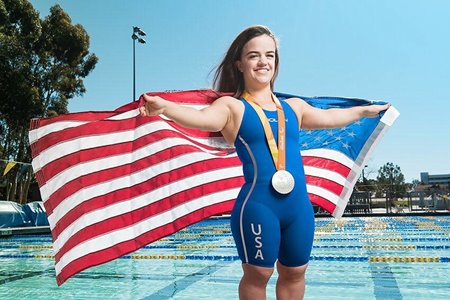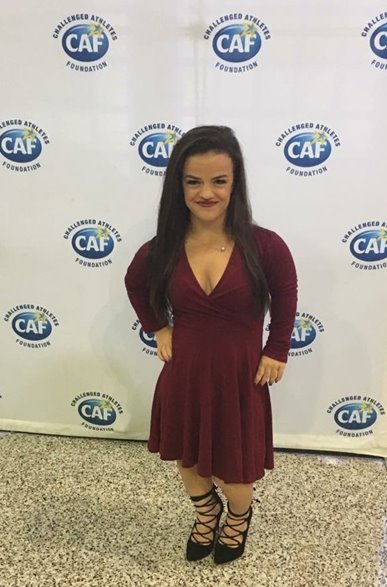Hello loyal blog readers! This month I had the chance to sit down (via Skype) with U.S. Paralympian Sophia Herzog, who just competed in the World Championship of Swimming. This interview will give you a chance to take a deeper look into Sophia’s training routine, her mental approach to the sport and her hopes for the Paralympic movement here in the United States. For those of you who want to follow Sophia’s journey to Tokyo 2020, you can find her at @sophiaherzog on Instagram and Twitter.
Before getting into Sophia’s interview, I want to remind my readers that RMF will be hosting our 10
th Annual RMF CT Wheelchair Basketball Camp at Loomis Chaffee, July 9 through 13. In addition, our 5
th Annual Hall of Fame game will be July 14
th sponsored by Stanley Black and Decker! More information for both events are available at
www.ryanmartinfoundation.org.
Now, my interview with Sophia Herzog:
 For someone who hasn’t had the pleasure of meeting you or doesn’t know your resume, tell our readers a bit about Sophia
For someone who hasn’t had the pleasure of meeting you or doesn’t know your resume, tell our readers a bit about Sophia.
I am an only child of two amazing parents Ralph and Trish, and the first dwarf in my family. I grew up in a town of 450 people and I was the first child to go through the school district with a physical disability. My school was too small to offer swimming so I traveled an hour to the nearest pool to swim. I decided to graduate high school in three years to be able to move to the Olympic Training Center and train in preparation for the Rio 2016 Paralympic Games where I earned a silver medal in the sb6 100m breaststroke. I am still currently training and recently just finished World Championships where I took home two gold, one silver and two bronze. Now we are in the final stretch for the road to Tokyo!
When did you first start swimming?
I learned to swim at three, joined my first club team at 12 and made the National Team at 17!
Readers often don’t get to see all that goes into being an elite-level Paralympic athlete. Take us behind the scenes and tell us about your training routine.
I reside at the Olympic Training Center in Colorado Springs, CO. I train under Nathan Manley who is absolutely incredible and I credit all my success to him. I swim nine times a week, I’m in the gym three times a week and practice yoga two times a week with Sundays off. I sleep about 8-10 hours every night.
Aside from the physical side of your training, what do you do from the mental side to get ready for high-level competitions?
I see a sports psychologist once a week. We are in 2018 so this is the last stretch to 2020. I am completely zoned in again and the excitement is up.
 What’s next for you? When’s your next major competition?
What’s next for you? When’s your next major competition?
Right now I am on the World Series tour, which just finished up in Italy and is now in Sheffield. Once done, I have a couple weeks before our major international competition of the year in Cairns, Australia called Pan/Pacific Championship that I am gearing up for.
What is the one thing you wish the American public knew about the Paralympic movement?
Being over here in the United Kingdom, the Paralympic athletes are almost more popular than their Olympic counterparts. I walk down the street with Eleanor Simmonds and people are constantly stopping to talk to her and snap photos. It’s incredible to see. I hope America will realize Paralympians work just as hard as our Olympic counterparts.
You’re very involved in CAF and giving back to your sport/future generations of adaptive athletes. Tell us about some of the projects you’re involved with outside of the pool.
I’m currently involved in CAF (Challenged Athletes Foundation) and Classroom Champions. I’m looking forward to the 25
th annual San Diego Triathlon Challenge this year. It’s amazing to see the younger generation finding love for sports and meeting kids just like them, with the same types of struggles, and feeding off each other in such a positive way. I became involved with Classroom Champions this year. They pair under-privileged kids with Olympic/Paralympic mentors and each month we send videos about goal setting, diversity, etc. I was actually lucky enough to visit two of my schools and meet my kids, face-to-face.
When you are all done swimming, what do you want your legacy to be?
I hope to inspire younger girls to be confident in themselves and love themselves and sports. It’s an incredible platform for it. It doesn’t have to be sports either; just finding something you’re truly passionate about.
The Paralympic movement continues to grow. More exposure. More Awareness. Where would you like to see the movement in the next 10 years?
I would like to see that people see no difference between the Paralympics and Olympics and that it gets equal coverage and awareness. I mean how thrilling is it to see fully blind athletes downhill skiing; not being able to see anything only listening to verbal ques while ripping down a mountain!
A special thank you to Sophia and best of luck on your road to 2020!!